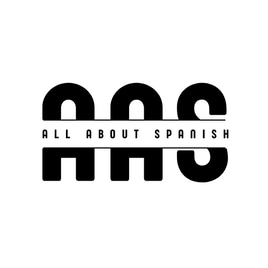START YOUR SPANISH LEARNING JOURNEY
PARTS OF SPEECH IN SPANISH
One of the most important part for beginners in Spanish grammar is parts of speech. Same as English there are 9 parts of speech, which you may already know such as nouns, pronouns, adjectives, verbs ,etc… Let’s find out in detail what these parts of speech are and how they are useful in Spanish grammar. Think of Part of speech in grammar as a house made from building blocks that kids play with. Part of speech will help you learn Spanish faster by sentence formation, word order or verb conjugation. Knowing these fundamental parts of speech will help you in reading, speaking and listening to Spanish with confidence.
12/12/20245 min read
There are hundreds and thousands of words in a language. Part of speech helps in categorizing these words into forming sentences. The parts of speech in Spanish (español) are :-
1. Noun
2. Pronoun
3. Adjectives
4. Adverbs
5. Prepositions
6. Verbs
7. Conjunction
8. Article
9. Interjection
For beginners, parts of speech are the most important in following the Spanish grammar rules. You will find lot of information below about these 9 categories.
What is a Part of Speech?
Part of Speech
1. ARTICLES (Los artículos)
Articles comes before noun to draw special attention to it. The two different types of articles are definite and indefinite articles. The type of article shows the way the speaker is talking about the noun. They could be talking about it in a general sense or as a specific thing.
Definite Articles (Artículos defenidos)
In English, ‘the’ is the only definite article. But in Spanish, there are 4 definite articles (artículos defenidos) ‘el ,la ,los ,las’. They specify which place, person or object the speaker is talking about.
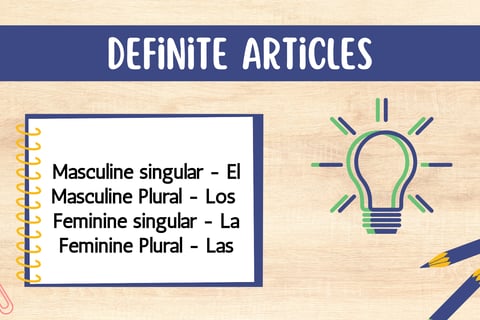

Let’s look at some of the examples.
El niño juega con la pelota. The boy plays with a ball.
Los estudiantes están en la clase. The students are in the class.
La niña tiene el pelo corto y marron. The girl has short and brown hair.
INDEFINITE ARTICLES (Artículos indefinidos)
Indefinite articles or Artículos indefinidos are a non specific way to refer to a noun. ‘A’ and ‘an’ are the only two indefinite articles that exist in English. But same as definite articles, indefinite articles are also four.
Again, these articles change according to the nouns that they precede.
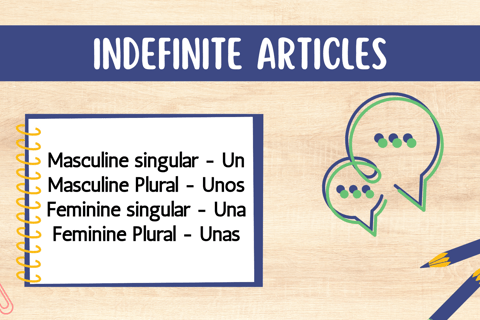

Let’s look at some of the examples.
Una profesora pone un boligrafo en la mesa. A teacher puts a pen on the table.
Un gato corre en la calle. A cat runs in the street.
2. NOUNS (Los Sustantivos)
Nouns or sustantivos in Spanish (español) are people, places and things, just like in English. But, in Spanish it can also be objects, feelings & even concepts. Nouns help you talk about imaginary or physical things.
Nouns basically are names that identify the objects, people and places.
In Spanish, nouns have genders but it does not mean they are physically feminine or masculine, it means things like tables and books have gender in grammatical sense. They must be used with adjectives or articles that match their gender.
El libro está sobre la mesa. (The book is on the table.)
Los niños juegan todo el día. ( The kids play all day.)
La niña corre en el jardín. (The girl runs in the garden.)
In Spanish, people as well as objects have genders. To determine if it is masculine or feminine, you must follow some rules.
3. ADJECTIVES (LOS ADJETIVOS)
Adjectives or los adjetivos describe nouns. You use them all the time! Adjectives add personality, creativity and detail to your sentences. They describe places, people and things around you.
Be careful while placing the adjectives. In Spanish, the adjectives comes after the noun they describe. Whereas in English, the adjectives come before the noun.
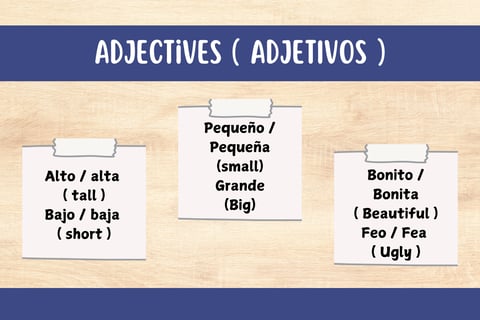

EXAMPLES
Carlos tiene una amiga muy bonita. (Carlos have a very beautiful friend.)
La profesora nueva pone el lápiz sobra la mesa sucia. (The new professor puts the pen on the dirty table.)
Los chicos traviosos juegan en la sala desorganizada. (The naughty kids play in the messy living room.)
4. VERBS (Los Verbos)
Los verbos (Verbs) describe a state of being or an action. Spanish verbs plays an important role in grammar for beginners. Every sentence have a verb!
The verbs below are in the infinitive form, i.e, in their neutral state. You will be able to tell if the verb is in its infinitive form by their ending. Verbs end in –er, –ar and –ir.
Spanish verbs require a lot of conjugation. Verbs are conjugated in present, future, past and other tenses. However, not all sentences use the verbs in it’s infinitive form.
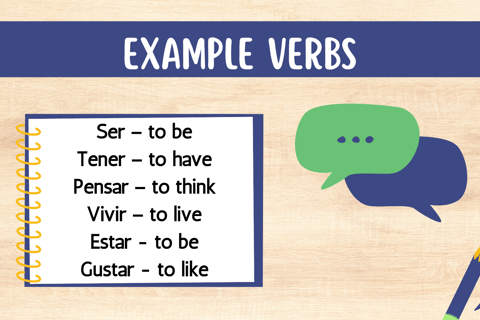

Let’s see if you can identify the verbs in the sentences below.
Carlos tiene una amiga muy bonita. (Verb tener )
Los chicos traviosos juegan en la sala desorganizada. (jugar)
5. ADVERBS (Los Adverbios)
Adverbs adds description to a verb, just like adjectives adds to a noun.
For example, instead of just saying “she reads”, you can say “she reads slow”.
Slow describes how the action is done.
In English, the adverbs mostly end in – ly. In Spanish los adverbios may have many forms, but they usually end in -mente.
Los chicos juegan silenciosamente en la sala. ( the kiddies play quietly in the drawing room.)
Los abuelos viven felizmente con sus hijos. (the grandparents live happily with their children.)
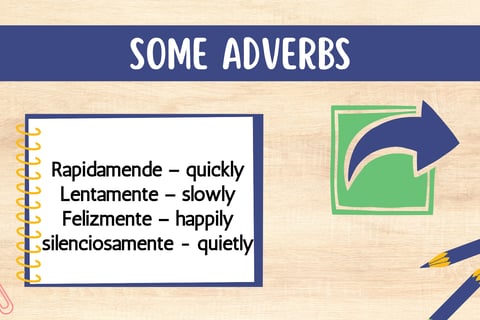

6. PRONOUNS (LOS PRONOMBRES)
A pronoun is a word that replaces a noun, by being a substitute of a noun. When telling a story, you don’t want repeat the same word over and over again. This repetition would sound cluttered and boring.
Take a look at the paragraph with pronouns:
My mother walked into the room. Then my mother told me my mother had a surprise. My mother bought a new car.
Now take a look at the same paragraph with pronouns:
My mother walked into the room. Then she told me that she had a surprise. She bought a new car.
Now you see, how important pronouns are! They make a paragraph more concise and clear.
Ella juega con su amiga.
Ellos tienen un examen mañana.
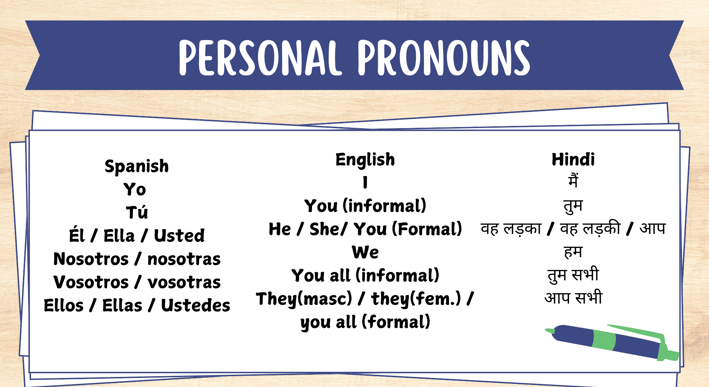

7.PREPOSITIONS (LAS PREPOSICIONES)
Preposiciones (Prepositions) tells you the relationships between noun. They often refer to a location and tell you how the two nouns are related.
En – on,in
Debajo – below
Cerca – near
Por – by, because of
Example sentences
Mi casa está cerca del mercado. (My house is near the market.)
Marta pone el libro en la mesa. (Marta puts the book on the table.)
La goma está debajo de la mesa/ la silla. (the eraser is under the table/the chair.)
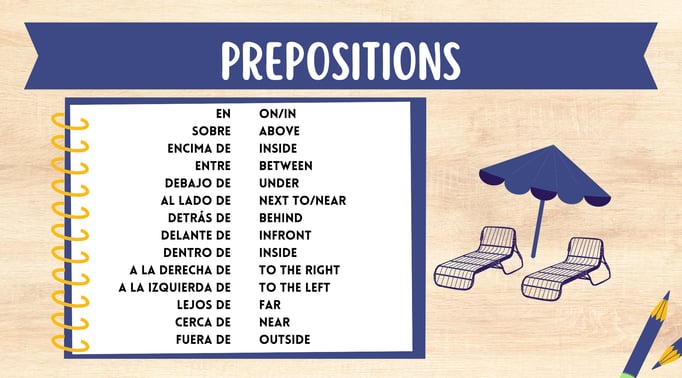

8. CONJUNCTIONS (LAS CONJUNCIONES)
Conjunctions are words that help you piece together different ideas and connect different phrases and sentences.
Simple and complex conjunctions are the two main types. Simple conjunctions are used all the time – “and (y)”, “but (pero)” and “or (o)”. On the other hand, Complex conjunctions are a little more deep – however (sin embargo), even though (aunque), therefore (por lo tanto) and so (así que).
Marta pone el libro en la mesa pero se cae.
Los niños jugaron todo el día, pero todavía tienen energía.
9. INTERJECTIONS (LAS INTERJECCIONES)
Interjections help you to express your feelings or emotions. They make your sentences seem much more natural.
In Spanish grammar, Interjections are a fun part for beginners. They are short words and phrases and are very easy to remember. Plus, the native speakers love hearing these sounds used by Spanish learners.
· ¡Vale! - okay
· ¡Dios mío! – oh my god
· ¡Venga! – come on
· ¡Ay! – hey
Interjections can have different meanings, so context is very important in decoding them. Volume, speed and pitch also helps show it’s meaning.
¡Ay! El niño está solo en la calle.
¡Venga! La clase ya ha empezado.
